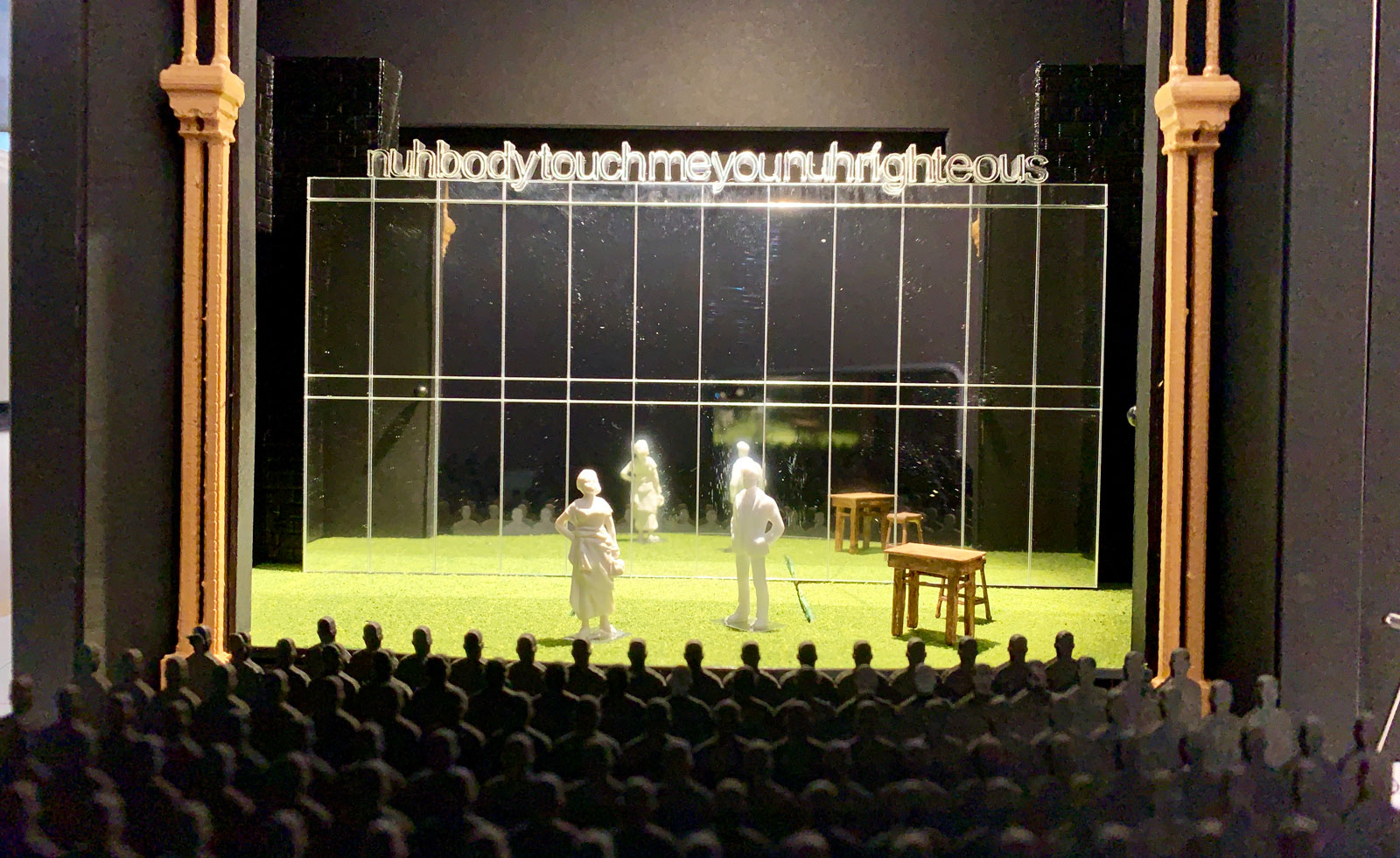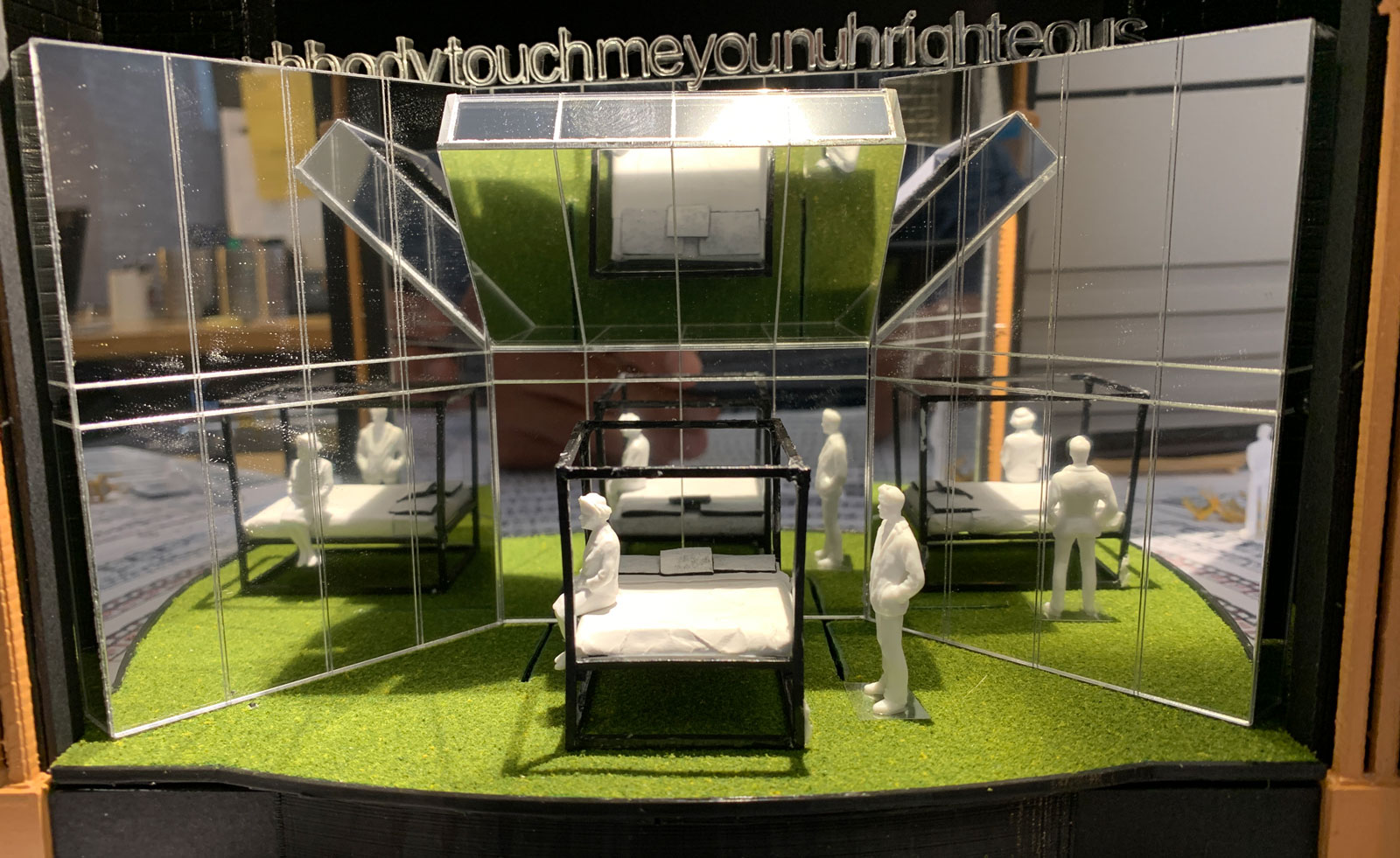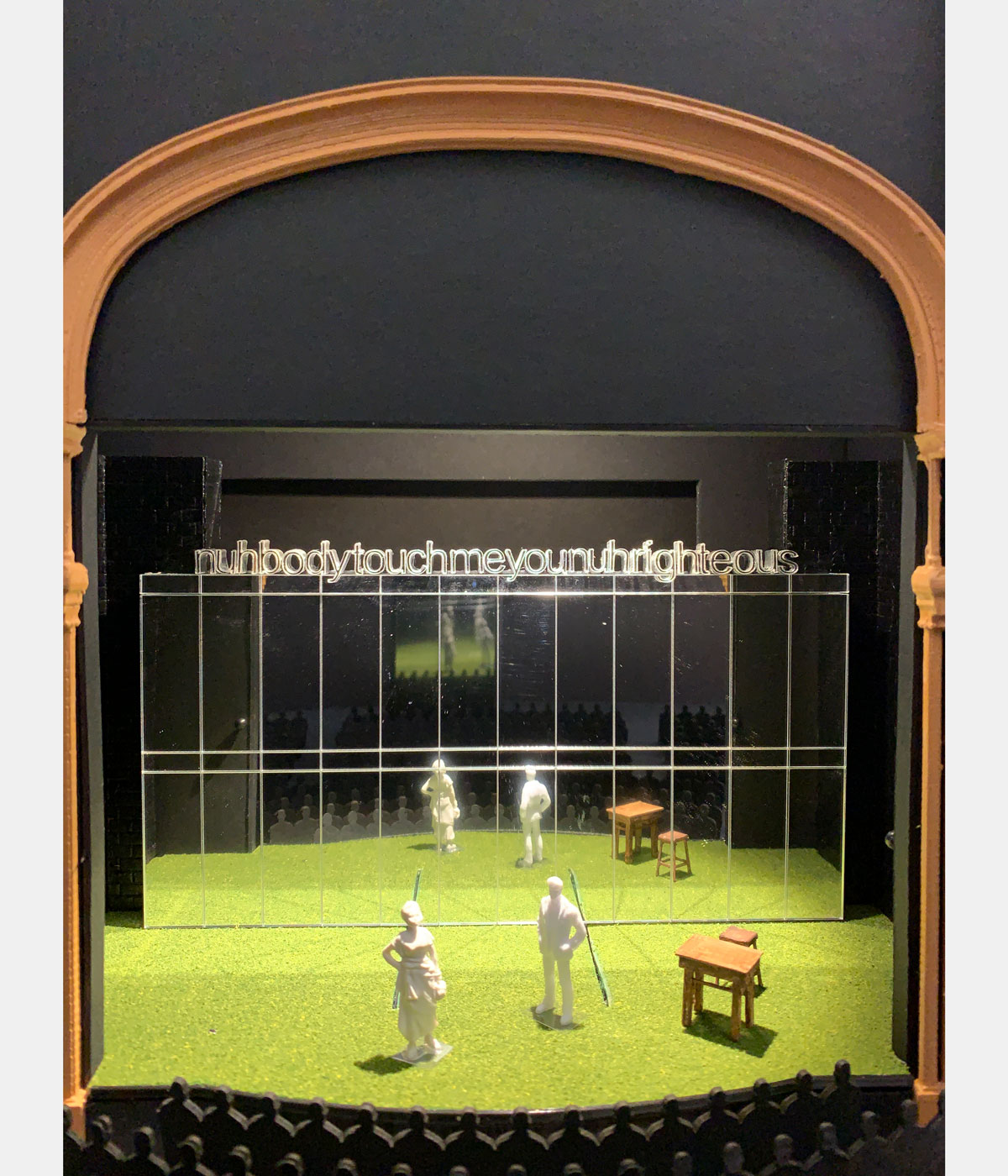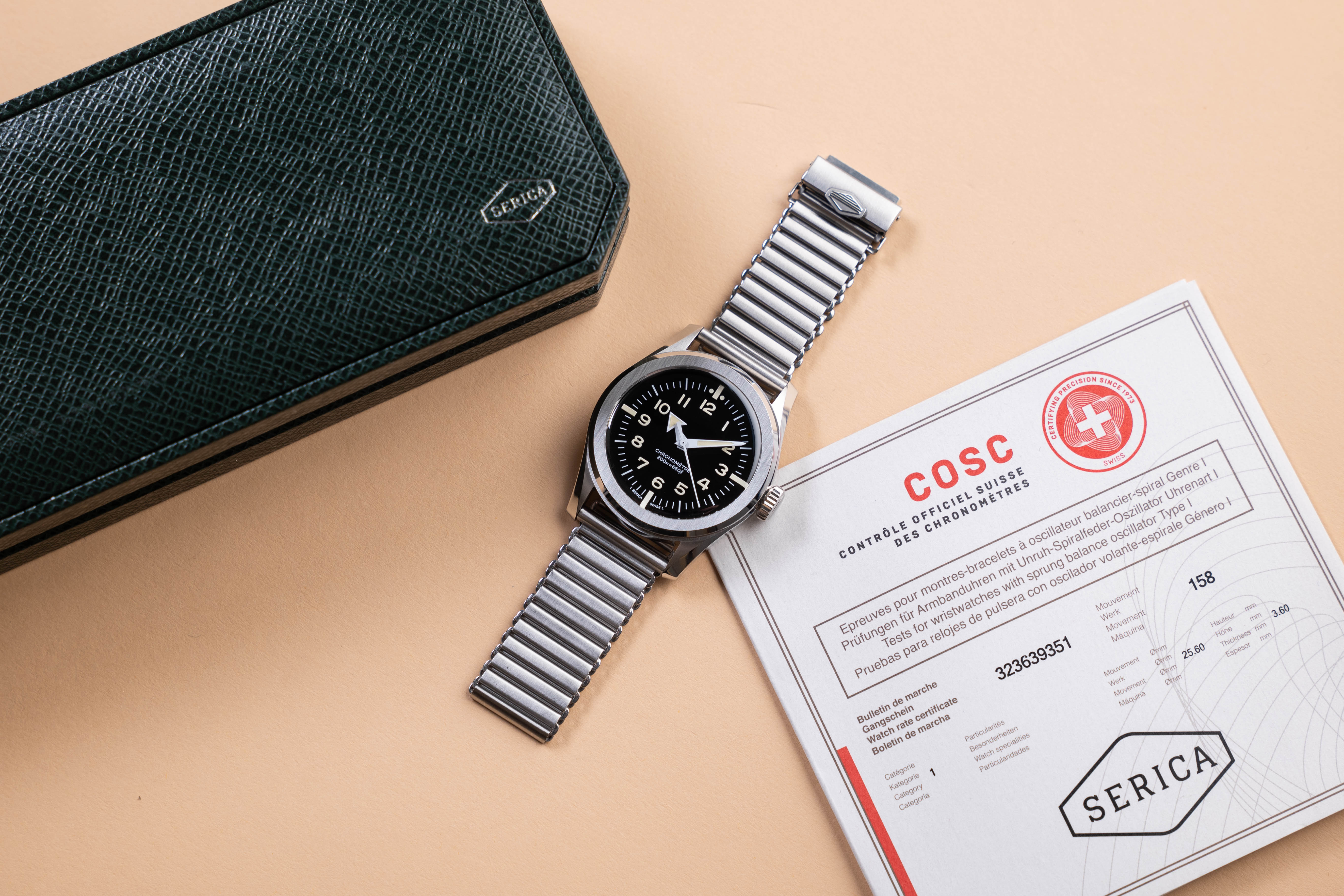‘A gentleness in the hard truths’: behind the scenes at Slave Play
Slave Play, London is on at the Noël Coward theatre – Amah-Rose Abrams reports on a ‘hilarious, tender, confronting’ performance and its masterful mirrored set

The announcement of Jeremy O Harris’ West End run of Slave Play was greeted with equal measures of glee and trepidation. What would London make of this controversial play that, while on Broadway, sparked debate to a level that a new play hasn’t done for years?
Since Slave Play’s debut in 2018, Harris has written art-world satirical melodrama Daddy, and co-produced smash hit, star-making series Euphoria. The sense of anarchy and the surreal level of realism common to all three projects is especially palpable in Slave Play, written while Harris was completing his master’s at Yale.
Slave Play review: ‘sex, relationships and power through the lens of race’

I enjoyed the play immensely, especially the way in which the writing radically seized permission to address power, sex, relationships and self-perception through the spectrum of race. The actors – a cast of eight, including Kit Harrington, Olivia Washington (daughter of Denzel), Fisayo Akinade, Aaron Heffernan, Chalia La Tour and Annie McNamara – clearly admire the work they are performing, and as a result put themselves in positions that felt like a gift.
Without giving away spoilers, hearing certain things said out loud can eradicate their power and I found the play hilarious, tender and very confronting, but in a way that I welcomed. For some people, it may be the entertainment equivalent of jumping into an iced plunge pool, and there are moments of extreme darkness wrapped in the masterful satire at play here. Against a background of millennial pop and indie favourites, there is a gentleness in the hard truths delivered by the cast over the play's two-hour duration, with no interval.
For some people, it may be the entertainment equivalent of jumping into an iced plunge pool
When the show’s set designer, Tony-winning Clint Ramos, read the script, he missed his train stop so he could keep reading.
'When I first read the play, which was in 2017, I think I was drawn to it not only because it broke so many taboos, but because it was talking about something that, as a man of colour and in an inter-racial relationship, really spoke to me and not only on a personal level; at least in America, and I think globally, it spoke to the zeitgeist,' he says. 'I called Robert (O’Hara) the director and unpacked what I was feeling when I initially read it, which was admiration, titillation, discomfort but also ultimately, excitement and how to craft a theatrical piece around what Jeremy had written. For me, the first impulse we have for every design is an emotional response, so a lot of those emotions guided me into the design itself.'
The play shatters taboos: it is at once hilarious and eviscerating and is a pleasantly disruptive, fresh and contemporary piece of writing. Parsing issues of race through ‘antebellum sex therapy’ creates an unavoidable intimacy and as the play takes us through the funny, the troubling, the dark and the violent, there is nowhere to hide.
Receive our daily digest of inspiration, escapism and design stories from around the world direct to your inbox.
The set design: mirrors open and tilt throughout

Slave Play’s greatness lies in its relationship with the audience. The set is built of mirrors, around which creeps the vegetation of the plantation it is set on. Throughout the action, the mirrors open and tilt, revealing the audience to itself, using the reflections of the actors and tessellating to accommodate the performance.
The idea was born out of a workaround of staging the production in the round, with the audience facing itself: 'The root of Jeremy's mandate was really that he wanted the audience to be immersed in the plantation, [to feel] that ephemeral thing that happens when you're in a place that has a history of oppression, that is real but [is also an idea around which there is] a spiritual envelope. Robert wanted the audience to be conscious of the performance. Seeing the actors while you're seeing the audience across for you was important to him.'
Ramos’ research led him to look at a lot of bedrooms, many of them with mirrored ceilings, and he began to think about intimacy and performance.
'I started playing around with mirrors, and then ultimately really landed on this idea… Why don't we just reflect ourselves onto it? And that also achieves what Jeremy was going for, which is because most of the audiences in the American theatre are white in a metaphorical way – we are already placing both the actors and the play itself in a plantation, in something that is charged, and which is basically a swathe of white people.'
‘The root of Jeremy's mandate was really that he wanted the audience to be immersed in the plantation… a place that has a history of oppression’
Clint Ramos
From the pop-out beds, hidden drawers and lyrics from a Rihanna song hanging over the action, the set accentuates the play in a powerful way. This was due to a collaborative approach embraced by Ramos, O’Hara and Harris.
'Our collaboration started in 2018, with Robert and Jeremy and all the other designers and it hasn't really stopped. Once I had the envelope of these walls of mirrors, it was really about what do we need for each particular scene? And the pop-up ideas facilitated the ideas of the hidden doors and within that [the set] opens up into these little vignettes, as if we're presenting middle stages. Again, it ties into this idea of how sex is performed, both for our partners or for ourselves.'
Great theatre creates great conversation, and people have something to say about Slave Play. Many have found it very liberating, appreciating its voicing of things lurking for too long as elephants in rooms. Exposing these long-engrained tropes requires us to look at ourselves, helping us question fundamental elements of our lives and relationships.
Slave Play, London is at the Noël Coward theatre until 21 September 2024
Amah-Rose Abrams is a British writer, editor and broadcaster covering arts and culture based in London. In her decade plus career she has covered and broken arts stories all over the world and has interviewed artists including Marina Abramovic, Nan Goldin, Ai Weiwei, Lubaina Himid and Herzog & de Meuron. She has also worked in content strategy and production.
-
 Click to buy: how will we buy watches in 2026?
Click to buy: how will we buy watches in 2026?Time was when a watch was bought only in a shop - the trying on was all part of the 'white glove' sales experience. But can the watch industry really put off the digital world any longer?
-
 Don't miss these art exhibitions to see in January
Don't miss these art exhibitions to see in JanuaryStart the year with an inspiring dose of culture - here are the best things to see in January
-
 Unmissable fashion exhibitions to add to your calendar in 2026
Unmissable fashion exhibitions to add to your calendar in 2026From a trip back to the 1990s at Tate Britain to retrospectives on Schiaparelli, Madame Grès and Vivienne Westwood, 2026 looks set to continue the renaissance of the fashion exhibition
-
 Out of office: The Wallpaper* editors’ picks of the week
Out of office: The Wallpaper* editors’ picks of the week'Tis the season for eating and drinking, and the Wallpaper* team embraced it wholeheartedly this week. Elsewhere: the best spot in Milan for clothing repairs and outdoor swimming in December
-
 Out of office: The Wallpaper* editors’ picks of the week
Out of office: The Wallpaper* editors’ picks of the weekFar from slowing down for the festive season, the Wallpaper* team is in full swing, hopping from events to openings this week. Sometimes work can feel like play – and we also had time for some festive cocktails and cinematic releases
-
 The Barbican is undergoing a huge revamp. Here’s what we know
The Barbican is undergoing a huge revamp. Here’s what we knowThe Barbican Centre is set to close in June 2028 for a year as part of a huge restoration plan to future-proof the brutalist Grade II-listed site
-
 Out of office: The Wallpaper* editors’ picks of the week
Out of office: The Wallpaper* editors’ picks of the weekIt’s wet, windy and wintry and, this week, the Wallpaper* team craved moments of escape. We found it in memories of the Mediterranean, flavours of Mexico, and immersions in the worlds of music and art
-
 Each mundane object tells a story at Pace’s tribute to the everyday
Each mundane object tells a story at Pace’s tribute to the everydayIn a group exhibition, ‘Monument to the Unimportant’, artists give the seemingly insignificant – from discarded clothes to weeds in cracks – a longer look
-
 Out of office: The Wallpaper* editors’ picks of the week
Out of office: The Wallpaper* editors’ picks of the weekThis week, the Wallpaper* team had its finger on the pulse of architecture, interiors and fashion – while also scooping the latest on the Radiohead reunion and London’s buzziest pizza
-
 Inside the design of Hamnet, a tale of Shakespeare’s real tragedy
Inside the design of Hamnet, a tale of Shakespeare’s real tragedyChloé Zhao’s new film Hamnet follows the tragedy and tenderness that led to Shakespeare’s seminal play, Hamlet. Production designer Fiona Crombie tells how she reimagined the Tudor-era spaces that shaped that very work
-
 Out of office: The Wallpaper* editors’ picks of the week
Out of office: The Wallpaper* editors’ picks of the weekIt’s been a week of escapism: daydreams of Ghana sparked by lively local projects, glimpses of Tokyo on nostalgic film rolls, and a charming foray into the heart of Christmas as the festive season kicks off in earnest